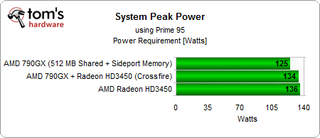Graphics Boosted: 790GX's Side-Port Explored
Power Requirement & Conclusion

System idle power was 65 W using only the chipset’s integrated graphics unit, and 11 W higher when installing the additional Radeon HD 3450 card. This was the case whether or not the system ran in Hybrid CrossFire mode.

The power consumption difference remains roughly the same at peak power when only the processor is at maximum load. Running a 3D-intensive benchmark does not result in peak power requirements that are much higher than this, as the graphics card requires less power at peak load than the processor.
Conclusion
AMD’s 790GX chipset isn’t able to deliver more system performance than any other Socket AM2+ compatible chipset—nor should it—as the most impactful component, the memory controller, is part of the processor. However, the platform delivers a modern computing experience and all of the features available today from AMD. This includes PowerPlay, CrossFireX, and Hybrid CrossFire, along with accelerated graphics performance plus powerful overclocking via Overdrive. While the 780G runs at a 500 MHz core clock, the 790GX clocks in at 700 MHz and consequently increases the value of the 780G chipset by a considerable margin. It also delivers added value when compared to Nvidia’s GeForce 8200/8300 mGPU.
However, our analysis focused on the side-port memory option that AMD has made available since the 780G chipset days, but which has not been used very often. Jetway’s HA07 Ultra comes with 128 MB DDR3 memory, which we found to be a valuable add-on when paired with shared memory. Using only the side-port memory results in the slowest possible 3D performance though, and AMD’s Radeon HD 3450 card with only 256 MB of memory also didn’t do really well on its own. In fact, the 790GX with its Radeon HD 3300 engine delivers better 3D performance than the HD 3450.
Side-Port Memory Helps
The most interesting benchmark run was the one where we used the 128 MB DDR3 side-port memory and 512 MB shared memory. This is the fastest possible setting in terms of 3D performance—only running the integrated graphics unit and a Radeon HD 3450 in Hybrid CrossFire mode was superior.
Stay on the Cutting Edge
Join the experts who read Tom's Hardware for the inside track on enthusiast PC tech news — and have for over 25 years. We'll send breaking news and in-depth reviews of CPUs, GPUs, AI, maker hardware and more straight to your inbox.
However, we recommend going straight for a higher-performing graphics solution instead of saddling yourself with such a low-impact hybrid solution. The side-port memory option does make a difference, but we can only recommend it if it comes at very little extra cost (just a few dollars). Most of the performance comes from AMD’s RV610-based 700 MHz DirectX 10 graphics unit.
Who Should Get 790GX?
Whether you get a high-end motherboard or a budget solution based on the 790GX chipset, the platform is modern, and delivers features and performance for all market segments paired with reasonable chipset cost. Hence, it is the best solution if you already know that you’ll upgrade the processor (Socket AM3 compatibility is there) or the graphics solution within a few months, or if you want one of the best AMD platforms with integrated graphics.
Most Popular

